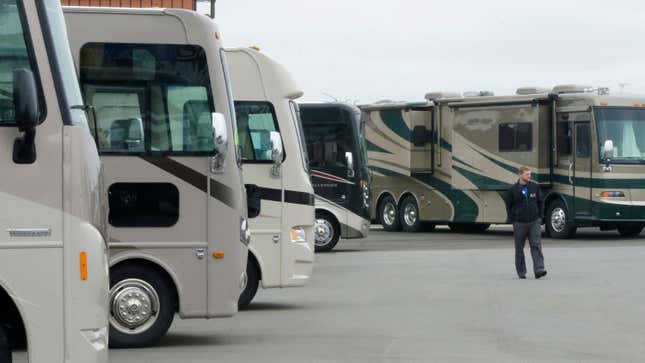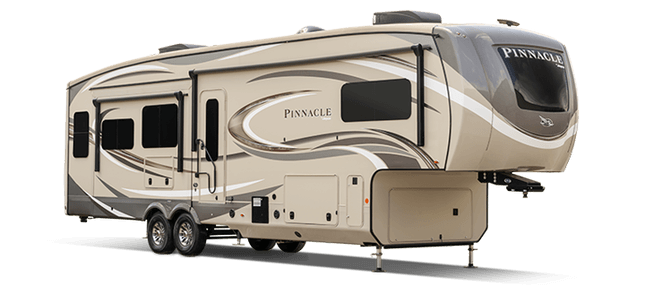Jezebel Investigates: Why Are RVs So Fucking Hideous?
Latest

Three years ago, right before the 2016 elections, I embarked on a road trip from New York City to southern California, cramming as many national parks and campgrounds as I could into two months, at times sleeping in the back of my car with my dog in truck stop parking lots. As you might imagine, this involved spending a lot of time traveling on America’s interstate highway system, where, as I passed RV after RV plastered with what resembled tribal tattoo decals or in some extreme cases, flames, I found myself obsessed by the question—why are so many RVs so fucking hideous? And why, despite this, do I desperately want one?
I’m not talking about a classic stainless steel Airstream, or an RV from the ’70s or ’80s whose main design element is a nice, simple stripe or two, or purveyors of the #vanlife. I’m talking about today’s monster motorhomes plastered with what the industry euphemistically describes as “swoops and swirls” and what I think of as the unfortunate spawn of Guy Fieri fucking a school bus. The kind of RVs that are the province of people who have $200,000 to spare and who want the freedom to see the beauty of America but in the tackiest, most gas-hungry, and sanitized method possible.
It turns out, I’m not the only person who has ever wondered about the aesthetic choices of RV manufacturers. Search the question, “Why are RVs so ugly,” and you’ll find there is a world of RV owners who hate how they look. It is a look that one blogger, the owner of an Airstream, has dubbed the “Energy Drink Aesthetic.” One commenter on cheaprvliving.com blamed the style on the “RV Exterior Vinyl Industrial Complex,” which I wholeheartedly believe, but still left me unsatisfied.
Could I find some answers?
To start my hunt, I reached out to Al Hesselbart, the former historian at the RV Museum and Hall of Fame in Elkhart, Indiana, the city that bills itself as the “RV Capital of the World.” (It’s estimated that more than 80 percent of all RVs built in the world are manufactured in or around the town of 50,000.) Hesselbart is the author of not one but two books on the history of RVs, a Robert Caro if you will of the recreational motorhome, regularly interviewed and cited on websites like RVBusiness.com and the RV Family Travel Atlas. In short, if anyone would know the answer to my question, it would be Hesselbart.
“I have never been sure,” Hesselbart told me when I reached him by phone and asked him why RVs are so fucking ugly these days. He added, to underscore his point, “I don’t understand.”
-

-

-

-

-

-

-

-

-

-

-

-

-

-

-

-

-

-

-

-

-

-

-

-

-

-

-

-

-

-

-

-

-

-

-

-

-

-

-

-









































